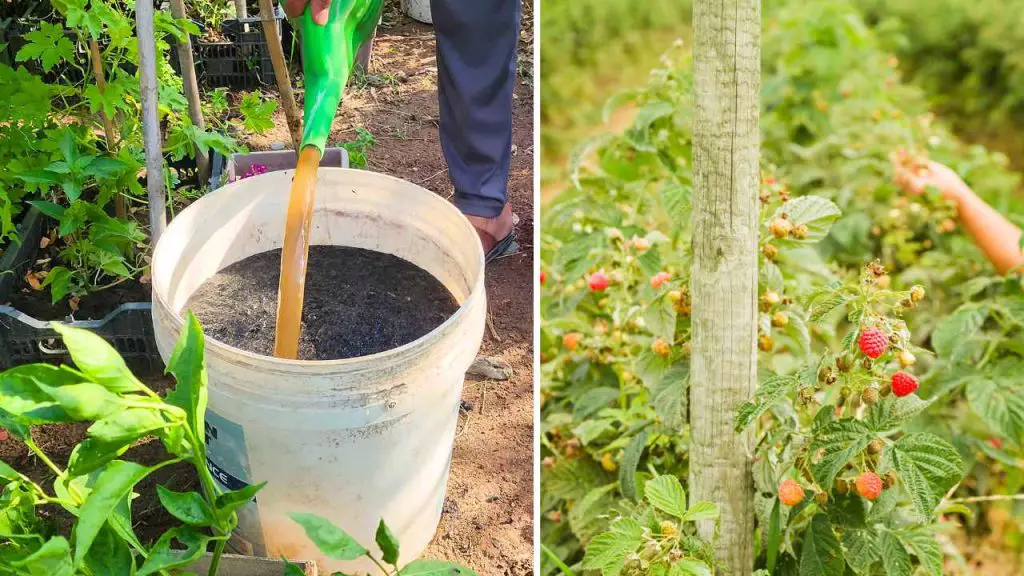This guide stresses how important it is to fertilize raspberry plants correctly so they grow well. It talks about how it affects growth, yield, and overall health, and it gives an overview of the benefits that come with doing things the right way.
Raspberries need a balanced amount of secondary nutrients like calcium, magnesium, sulfur, and trace elements like iron, manganese, zinc, copper, molybdenum, and boron in order to grow. Primary nutrients include nitrogen, phosphorus, potassium, calcium, magnesium, and sulfur.

Raspberry plants need to be fertilized in order to grow well and produce more fruit. It gives plants the nutrients they need for strong vegetative growth, which makes them healthier and gives them strong canes and leaves.
The amount and quality of fruit also improve when nutrients are managed correctly. Nutrient-deficient plants are stronger when they are fertilized properly, which makes them less likely to get diseases or be eaten by pests.
It also helps raspberry plants stay healthy and productive over time, so they can keep producing fruit for many growing seasons.
Benefits of Correct Fertilization Practices
Raspberries get bigger, more plentiful, tastier, more colorful, and smoother when they are fertilized. This makes it easier to sell and makes customers happier.
Also, raspberry plants that have been fertilized grow quickly and have lush leaves and strong canes that can support heavy loads of fruit and quickly recover from environmental stresses.
When you fertilize your plants the right way, the nutrients are used efficiently, and there is less waste and damage to the environment. This helps agriculture last longer by stopping nutrients from washing into waterways.
By improving the way fertilization is done, you can get better results with less money. This means you won’t have to use as many extra treatments and interventions, which saves you time and money.
Proper fertilization is important for growing raspberries because it makes sure the plants get the nutrients they need for strong growth, good fruit production, and resistance to pests and diseases.
It fits with environmentally friendly farming methods, lowers the need for chemicals, and encourages plant and animal life. Growers can get the best results from fertilization and keep their raspberry plants healthy and productive for a long time by following best practices.
Choosing the Right Fertilizer for Raspberries
Organic Options
Compost, well-rotted manure, fish emulsion, and bone meal are all natural ways to improve the health of the soil. Compost releases nutrients slowly and improves the structure of the soil.
Manure that has been well-rotted is also full of nutrients and organic matter. Fish emulsion is a nitrogen-rich liquid fertilizer that is great for early plant growth. Bone meal, which is high in phosphorus, helps plants grow roots and flowers. It should be mixed into the soil before planting.
Inorganic Options
Balanced commercial fertilizers give plants all the nutrients they need. Mixtures like 10-10-10 or 20-20-20 dissolve in water and are available to plants right away.
Soil amendments, like lime and sulfur, can be used to raise the pH of the soil and make it a better place for raspberry plants to grow. If the pH is too high, lime makes nutrients more available; if it is too low, sulfur lowers it.
It is important to check the pH of the soil before applying and to use the right amount. You can give your raspberry plants the best conditions for growth by carefully choosing and adding the right fertilizers and amendments.
Soil Testing for Raspberries
Soil testing is important to know the pH and nutrient levels of the soil so that the right amount of fertilizer can be applied. In order to do a test, you will need to dig holes 6 to 8 inches deep in your raspberry patch and take a slice of soil from each one.
Bring the soil samples together in a clean bucket, and then send the bucket full of soil to a lab to be analyzed. This process makes sure that the results of your soil management are correct and reliable.
The results of a soil test tell you about the pH level, the amount of nutrients (nitrogen, phosphorus, potassium, and micronutrients), and the amount of organic matter in the soil.
Adjusting Nutrient Levels and pH
To change raspberries’ pH, use lime to bring it up to the best range of 5.5–6.5 or sulfur to bring it down to the alkaline range you want. Use a high-nitrogen fertilizer, like fish emulsion or balanced commercial fertilizer, to raise nitrogen levels and change the levels of other nutrients.
If your plants need more phosphorus, use bone meal or a balanced fertilizer. If they need more potassium, use a potassium-specific fertilizer like potassium sulfate. If it is found that micronutrients are missing, they should be added with a micronutrient supplement or certain organic amendments.
Timing of Fertilization
When you fertilize raspberry plants is very important for getting the most benefits and the fewest problems. This way, you make sure that the nutrients they need are available when they need them, which helps them grow and produce fruit.
Early Spring: Primary Application Time before New Growth Begins
Raspberries need to be fertilized early in the spring so they can get the nutrients they need as they come out of dormancy and start to grow again. When to apply depends on the weather where you live, and making sure the nutrients are there when the plants need them is important.
It is best to use a balanced fertilizer like 10-10-10 or 20-20-20. Spread the fertilizer out evenly around the base of the plant so that the roots don’t get burned. Make sure not to put too much fertilizer close to the canes. It should either be lightly mixed into the soil or given a lot of water.
Mid-Summer: Additional Light Application if Needed
Applying fertilizer in the middle of summer can help plants grow and fruits develop, especially if a lack of nutrients is found. It should be used after the first big fruiting period and while the plants are still growing.
To keep plants from growing too quickly, you can use a balanced fertilizer with a slightly lower nitrogen content. Spread it out lightly and evenly around the plants, and water them to help the nutrients get to the roots. If you don’t want too much new growth, don’t apply too late in the summer.
Avoiding Late Season Fertilization
Avoid fertilizing plants too late in the season, usually between late August and early September, so they have time to go into their dormant phase. This will protect them from cold damage and health problems. At this point in time, plants can naturally move into their dormant phase.
But fertilizing too late can cause new growth that is soft and easily damaged by frost. This makes the plant more likely to be damaged in the winter and could make it less vigorous and productive the next season.

Application Techniques for Fertilizing Raspberries:
Broadcasting: The process involves spreading fertilizer evenly over the whole surface of the soil in a raspberry patch. How much to use depends on the size of the patch and the results of a soil test. You can use a broadcast spreader or do it by hand. To keep nutrients from running off, the soil should be lightly raked.
Banding: To use this method, spread fertilizer along the row of raspberry plants in a narrow band that is 2 to 4 inches deep and 2 to 4 inches away from the plants’ bases. This method cuts down on waste and improves the plant’s ability to absorb nutrients because it makes it easy for the roots to get to the nutrients.
Side-Dressing: During the growing season, to fertilize established raspberry plants, you need to figure out how much you need based on their size and age, then apply the fertilizer in a circle or half-circle around the plant, 6 to 12 inches from the canes, and work it lightly into the soil surface without disturbing the roots.
Giving the plants a lot of water helps the fertilizer break down and brings nutrients to the roots. This gives the plant even more nutrients during important growth times.
Using these methods will make sure that the nutrients get to your raspberry plants quickly and effectively, encouraging healthy growth and increasing the number of fruits they produce.
Watering After Fertilization
After fertilizing, raspberry plants need to be properly watered so that they can absorb and use nutrients effectively. Water is important for plant health and nutrient uptake.
Importance of Moisture
Water is very important for plant growth because it helps nutrients dissolve and roots take them in. It breaks down fertilizers so that plant roots can absorb them. Having enough water in the soil makes sure that nutrients get to the roots and stops root burn.
When you water, the fertilizer is diluted and spread out evenly, which lowers the risk of damaging the roots. Having the right amount of water and nutrients from fertilizer helps plants grow in a healthy way.
But too much water stress can make it hard for plants to absorb nutrients, which can hurt their overall health and productivity. So, giving plants the right amount of water is essential for their growth.
Related Articles:
- 15 Simple And Inexpensive Homemade Fertilizers
- Best Source Of Calcium For Tomato Plants And Other Vegetables
- How To Make Liquid Fertilizer At Home For Your Plants?
Monitoring and Adjusting Fertilizer for Raspberries
The health of a plant is very important for its growth and development. Micronutrient deficiencies, stunted growth, dark green or purple leaves, poor root development, delayed maturity, weak stems, bad fruit quality, and leaves that turn yellow or brown are all signs of not getting enough nutrients.
Too much of a nutrient can make plants grow too many leaves, make them more vulnerable to pests and diseases, and stop them from absorbing other nutrients.
To make seasonal changes, you can use balanced fertilizers in early spring, compost or well-rotted manure for slow-release nutrients, add more fertilizer in the middle of summer, and think about using a balanced fertilizer or fish emulsion as a side dressing.
From late summer to fall, don’t fertilize as much or at all to protect plants from frost damage. Instead, use organic mulches and compost to keep the soil healthy. Regular monitoring includes checking for nutrient deficiencies or excesses often and testing the soil every one to two years to keep an eye on the pH and nutrient levels.
Environmental and Safety Considerations for Fertilizing Raspberries
Apply fertilizers at the recommended rates, keep buffer zones up, use slow-release or organic fertilizers, stay away from fertilizers near bodies of water, use cover crops and mulches, and don’t fertilize before it rains a lot.
Safety measures should be taken, like reading labels, wearing protective gear, and not breathing in the substance. Put fertilizers away safely in a cool, dry place and keep them in the containers they came in. Clean up spills right away and throw away trash the right way.
To fertilize raspberries correctly, you need to pick the right kind, test the soil, use the right fertilizers, and keep an eye on the plant’s health. To encourage healthy growth, protect the environment, and keep yourself safe, use safe practices and safety precautions. Change your fertilization plan often based on how the plants are doing and the state of the soil.
